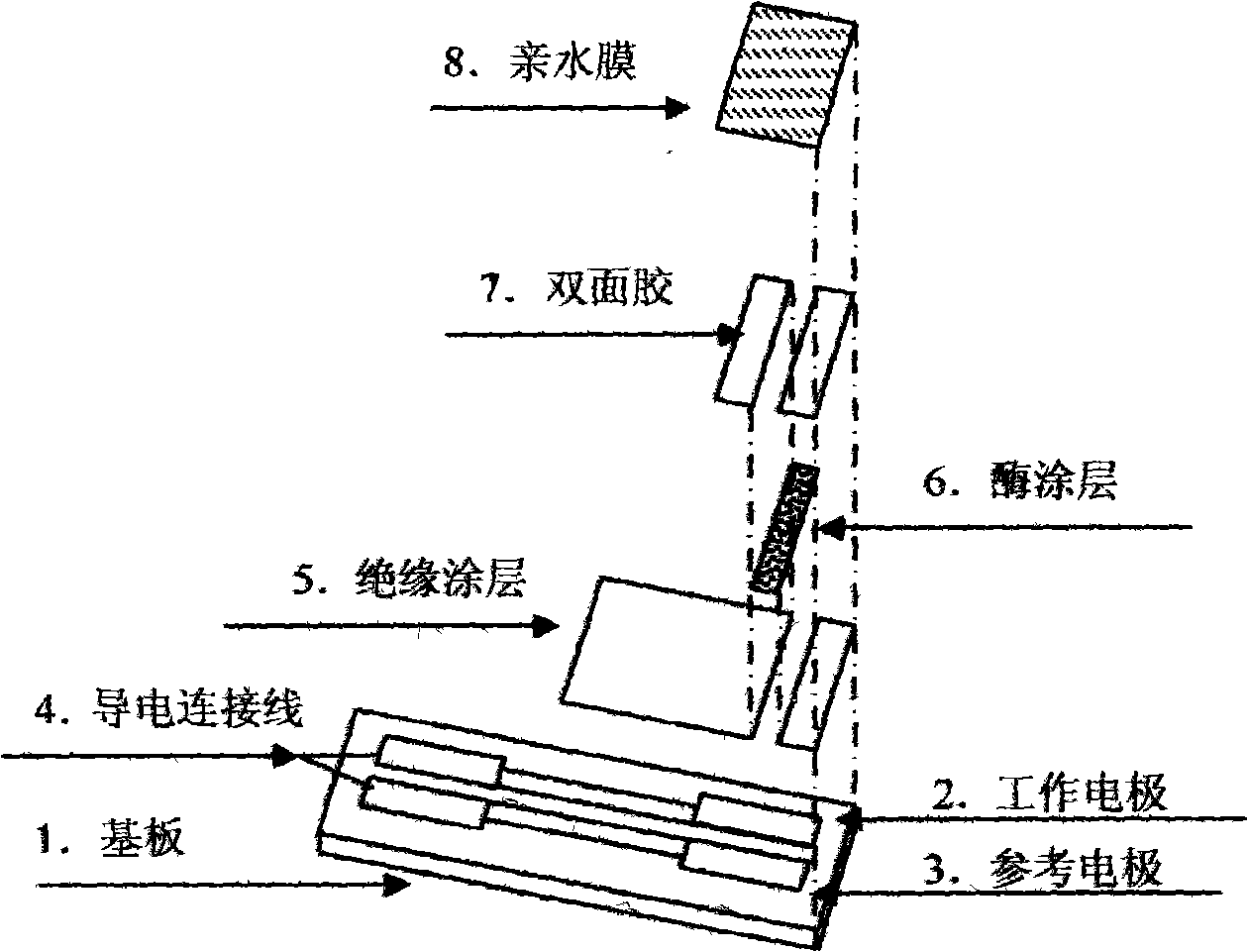Method for manufacturing rapid blood sugar test paper
A technology for testing test strips and production methods, which is applied in the field of biosensing, and can solve the problems of complex production process, expensive materials and unfavorable industrial scale production of products, so as to optimize the production process, facilitate post-processing and packaging, and reduce production equipment Effect
- Summary
- Abstract
- Description
- Claims
- Application Information
AI Technical Summary
Problems solved by technology
Method used
Image
Examples
Embodiment 1
[0018] Embodiment 1: Polyphenylene (PP) synthetic paper, cut into 300X300 centimeter substrate in advance for later use.
[0019] (1) 1 gram of silk-screen conductive carbon ink (Acheson 423SS) was mechanically stirred for 30 minutes, mixed well and set aside.
[0020] (2) Fix the 300-mesh metal or nylon polyester wire mesh on a square light metal frame, apply Kodak photosensitive glue in the dark room, and dry it for later use.
[0021] (3) Place the computer-drawn negatives of the working electrode and the reference electrode on the photosensitive adhesive, and expose them to a 20-watt ultraviolet lamp for 15 minutes. Rinse off the unhardened photosensitive adhesive covered by the electrode negative with a high-pressure water gun. After drying, a screen printing template is formed.
[0022] (4) Install the screen printing template with the working electrode and reference electrode graphics on the automatic screen printing machine for standby.
[0023] (5) Glucose oxidase ...
Embodiment 2
[0026] Embodiment 2: polyester (PET) sheet material, cut into 300 * 300 centimeter substrates in advance for later use.
[0027] (1) Mechanically stir and mix the silk screen conductive carbon ink for later use.
[0028] (2) Fix the 300-mesh metal or nylon polyester wire mesh on a square light metal frame, apply Kodak photosensitive glue in the dark room, and dry it for later use.
[0029] (3) Place the computer-drawn negatives of the working electrode and the reference electrode on the photosensitive adhesive, and expose them to light for 25 minutes under a 20-watt ultraviolet lamp. Rinse off the unhardened photosensitive adhesive covered by the electrode negative with a high-pressure water gun. After drying, a screen printing template is formed.
[0030] (4) Install the screen printing template with the working electrode and reference electrode graphics on the automatic screen printing machine for standby.
[0031] (5) Glucose dehydrogenase with an activity of 350 interna...
Embodiment 3
[0033] Embodiment 3: Polyphenol ester (PP) boards, which are pre-cut into 300×300 cm substrates for later use.
[0034] (1) Mechanically mix the silk screen conductive carbon ink for standby;
[0035] (2) Fix the 300-mesh metal or nylon polyester material screen on the square light metal frame, apply Kodak photosensitive glue in the dark room, and dry it for later use;
[0036] (3) Place the working electrode and the reference electrode negative film drawn by the computer on the photosensitive glue, expose to light for 30 minutes under a 40-watt ultraviolet lamp, rinse off the unhardened photosensitive glue covered by the electrode negative film with a high-pressure water gun, and form a silk screen template after drying;
[0037] (4) Install the screen printing template with working electrode and reference electrode graphics on the automatic screen printing machine for standby;
[0038] (5) Glucokinase with an activity of 120 international units was added to 120 millimoles p...
PUM
 Login to View More
Login to View More Abstract
Description
Claims
Application Information
 Login to View More
Login to View More - R&D
- Intellectual Property
- Life Sciences
- Materials
- Tech Scout
- Unparalleled Data Quality
- Higher Quality Content
- 60% Fewer Hallucinations
Browse by: Latest US Patents, China's latest patents, Technical Efficacy Thesaurus, Application Domain, Technology Topic, Popular Technical Reports.
© 2025 PatSnap. All rights reserved.Legal|Privacy policy|Modern Slavery Act Transparency Statement|Sitemap|About US| Contact US: help@patsnap.com

